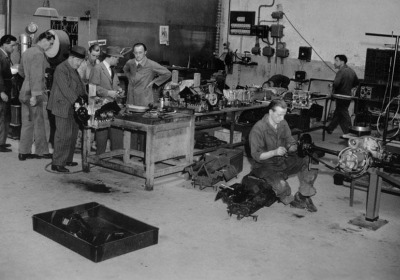Porsche museum holds treasure trove of history
Tue, 09 Nov 2010
Ferdinand and Ferry Porsche shared one characteristic with other automotive icons such as Enzo Ferrari and E. L. Cord: a complete concentration on building the future and little interest in the past.
However, in more recent times, automakers have come to realize the value of their history, Porsche among them.
In a quiet corner with no signs in the Porsche museum in Zuffenhausen, Germany, are a number of fireproof vaults and a huge library. This is Porsche's DNA.
Available to researchers and writers, hundreds of thousands of period photographs and negatives are stored, along with all company publications. It's likely that everyone who has ever written a book on the marque has spent a lot of time here.
Ferdinand Porsche was near the end of his life when the first Porsche car was built in 1948. But he had been building and designing cars for almost 50 years, including a hybrid at the turn of the 20th century, the iconic supercharged Mercedes-Benz SSK sports cars of the 1920s, the rear-engined Auto Union Silver Arrows, the Volkswagen, and finally, along with his son, the car that bore his name.
Most of the records of Porsche's design firm were lost in World War II, but the archives still contain Porsche family albums and photographs going back to 1900.
The main focus of the library, however, is from 1948 onward. Period photographs of every Porsche produced are catalogued, as are photographs from every competitive event the factory entered, plus many others. Most have never been published.
A huge collection of rare catalogs and posters is also stored, as is virtually every works manual.
Jens Torner, the Porsche archivist with primary responsibility for motorsports, pulls opens a drawer and brings out the first catalog for the 356, still in mint condition.
I pick up a grimy parts catalog for the Carrera 6, oil-stained and dog-eared like many of the technical manuals.
Although the collection is virtually complete, there are a couple of things missing:
-- A few catalogs for the 356SL race car were produced and are now worth a fortune.
-- No period photo of the 356C G2000S Carrera 2 Cabrio can be found.
But that's about it.
Original works drawings are kept in a separate archive in Weissach, Germany. Porsche is not convinced of the longevity of digital storage, so all original drawings are also photographed using traditional cameras.
Torner pulls out proofs of photos from the first days of hand-built cars in cramped conditions, unpublished photos of 917s in action and the last-known photo of Ferdinand Porsche.
New material is always being added, including rare collections of racing posters from around the world, sometimes donated by collectors.
A varied collection of memorabilia is stored. On a shelf sits one of the original styling models for the 917 which was never built, alongside a perfect model 911 made of chocolate. It's like being in someone's amazing historical attic.
The archive does not authenticate individual cars, although it is certainly helpful in locating original photographs of cars that have significant provenance.
Of course, it helps to be able to walk downstairs to the museum and the attached garage. On the floor, an original Formula One car is being serviced, alongside the 1970 Le Mans-winning 917 and some other jaw-dropping cars. A few of the rarest customer cars make it to this, the best Porsche garage of the lot.
Given the lack of interest in history that the Porsches had, it's amazing that it all survived intact and became the authoritative source for those with a keen interest in Porsche's past.
By Ronan McGrath

